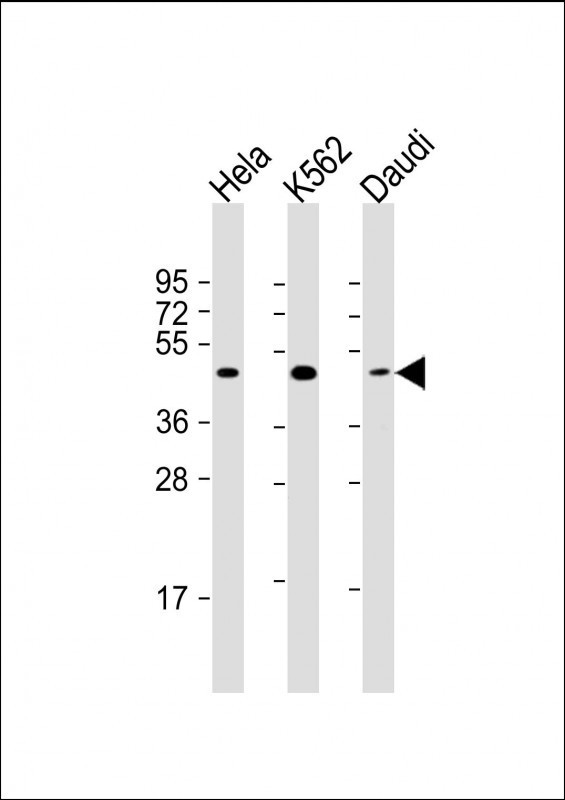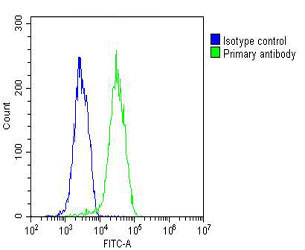PLIN3 Antibody
Purified Mouse Monoclonal Antibody (Mab)
- SPECIFICATION
- CITATIONS
- PROTOCOLS
- BACKGROUND

Application
| WB, FC, E |
|---|---|
| Primary Accession | O60664 |
| Reactivity | Human |
| Host | Mouse |
| Clonality | monoclonal |
| Isotype | IgG2a,k |
| Clone/Animal Names | 1651CT490.66.85 |
| Calculated MW | 47075 Da |
| Gene ID | 10226 |
|---|---|
| Other Names | Perilipin-3, 47 kDa mannose 6-phosphate receptor-binding protein, 47 kDa MPR-binding protein, Cargo selection protein TIP47, Mannose-6-phosphate receptor-binding protein 1, Placental protein 17, PP17, PLIN3, M6PRBP1, TIP47 |
| Target/Specificity | This PLIN3 antibody is generated from a mouse immunized with a KLH conjugated synthetic peptide between 1-434 amino acids from human PLIN3. |
| Dilution | WB~~1:2000 FC~~1:25 E~~Use at an assay dependent concentration. |
| Format | Purified monoclonal antibody supplied in PBS with 0.09% (W/V) sodium azide. This antibody is purified through a protein G column, followed by dialysis against PBS. |
| Storage | Maintain refrigerated at 2-8°C for up to 2 weeks. For long term storage store at -20°C in small aliquots to prevent freeze-thaw cycles. |
| Precautions | PLIN3 Antibody is for research use only and not for use in diagnostic or therapeutic procedures. |
| Name | PLIN3 |
|---|---|
| Synonyms | M6PRBP1, TIP47 {ECO:0000303|PubMed:95901 |
| Function | Structural component of lipid droplets, which is required for the formation and maintenance of lipid storage droplets (PubMed:34077757). Required for the transport of mannose 6-phosphate receptors (MPR) from endosomes to the trans-Golgi network (PubMed:9590177). |
| Cellular Location | Lipid droplet. Endosome membrane; Peripheral membrane protein; Cytoplasmic side. Cytoplasm. Note=Membrane associated on endosomes (PubMed:15545278). Detected in the envelope and the core of lipid bodies and in lipid sails (PubMed:15545278) |

Thousands of laboratories across the world have published research that depended on the performance of antibodies from Abcepta to advance their research. Check out links to articles that cite our products in major peer-reviewed journals, organized by research category.
info@abcepta.com, and receive a free "I Love Antibodies" mug.
Provided below are standard protocols that you may find useful for product applications.
Background
Required for the transport of mannose 6-phosphate receptors (MPR) from endosomes to the trans-Golgi network.
References
Diaz E.,et al.Cell 93:433-443(1998).
Than N.G.,et al.Eur. J. Biochem. 258:752-757(1998).
Than N.G.,et al.Tumor Biol. 20:184-192(1999).
Kalnine N.,et al.Submitted (MAY-2003) to the EMBL/GenBank/DDBJ databases.
Ota T.,et al.Nat. Genet. 36:40-45(2004).
If you have used an Abcepta product and would like to share how it has performed, please click on the "Submit Review" button and provide the requested information. Our staff will examine and post your review and contact you if needed.
If you have any additional inquiries please email technical services at tech@abcepta.com.













 Foundational characteristics of cancer include proliferation, angiogenesis, migration, evasion of apoptosis, and cellular immortality. Find key markers for these cellular processes and antibodies to detect them.
Foundational characteristics of cancer include proliferation, angiogenesis, migration, evasion of apoptosis, and cellular immortality. Find key markers for these cellular processes and antibodies to detect them. The SUMOplot™ Analysis Program predicts and scores sumoylation sites in your protein. SUMOylation is a post-translational modification involved in various cellular processes, such as nuclear-cytosolic transport, transcriptional regulation, apoptosis, protein stability, response to stress, and progression through the cell cycle.
The SUMOplot™ Analysis Program predicts and scores sumoylation sites in your protein. SUMOylation is a post-translational modification involved in various cellular processes, such as nuclear-cytosolic transport, transcriptional regulation, apoptosis, protein stability, response to stress, and progression through the cell cycle. The Autophagy Receptor Motif Plotter predicts and scores autophagy receptor binding sites in your protein. Identifying proteins connected to this pathway is critical to understanding the role of autophagy in physiological as well as pathological processes such as development, differentiation, neurodegenerative diseases, stress, infection, and cancer.
The Autophagy Receptor Motif Plotter predicts and scores autophagy receptor binding sites in your protein. Identifying proteins connected to this pathway is critical to understanding the role of autophagy in physiological as well as pathological processes such as development, differentiation, neurodegenerative diseases, stress, infection, and cancer.



